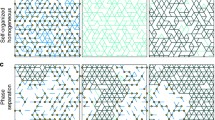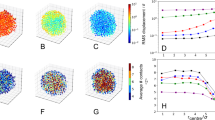Abstract
The continuous random network model is widely used as a realistic description of the structure of covalent glasses and amorphous solids. We point out that, in real glasses and amorphous materials, there are nonrandom structural elements that go beyond just simple chemical ordering. We propose that the network can self-organize at its formation or fictive temperature and examine some of the possible consequences of such self-organization. We find that the absence of small rings can cause the mechanical threshold to change from a second-order to a first-order transition. We show that, if stressed regions are inhibited in the network, then there are two phase transitions and an intermediate phase that is rigid but stress-free. This intermediate phase is bounded by a second-order transition, on the one hand, and a first-order transition, on the other. Recent experiments in chalcogenide glasses give evidence for this intermediate phase.
Similar content being viewed by others
REFERENCES
Zachariasen, W.H., The Atomic Arrangement in Glass, J.Am. Chem. Soc., 1932, vol. 54, pp. 3841-3851.
Polk, D.E., Structural Model for Amorphous Silicon and Germanium, J. Non-Cryst. Solids, 1971, vol. 5, no. 5, pp. 365-376.
Wooten, F., Winer, K., and Weaire, D., Computer Generation of Structural Models of Amorphous Si and Ge, Phys. Rev. Lett., 1985, vol. 54, no. 13, pp. 1392-1395.
Kirkwood, J.G., Skeletal Modes of Vibration of Long Chain Molecules, J. Chem. Phys., 1939, vol. 7, pp. 506-512.
Keating, P.N., Effect of Invariance Requirements on the Elastic Strain Energy of Crystals with Application to the Diamond Structure, Phys. Rev., 1966, vol. 145, no. 2, pp. 637-645.
Car, R. and Parrinello, M., Unified Approach for Molecular Dynamics and Density-Functional Theory, Phys. Rev. Lett., 1985, vol. 55, no. 22, pp. 2471-2474.
Barkema, G.T. and Mousseau, N., Event-Based Relaxation of Continuous Disordered Systems, Phys. Rev. Lett., 1966, vol. 77, pp. 4358-4364.
Feng, X.W., Bresser, W.J., and Boolchand, P., Direct Evidence for Stiffness Threshold in Chalcogenide Glasses, Phys. Rev. Lett., 1997, vol. 78, no. 23, pp. 4422-4425.
Boolchand, P., Feng, X.W., Selvanathan, D., and Bresser, W.J., Rigidity Transition in Chalcogenide Glasses, in Rigidity Theory and Applications, New York: Kluwer Academic/Plenum, 1999.
Selvanathan, D., Bresser, W.J., Boolchand, P., and Goodman, B., Thermally Reversing Window and Stiffness Transitions in Chalcogenide Glasses, Solid State Commun., 1999, vol. 111, pp. 619-627.
Thorpe, M.F., Continuous Deformations in Random Networks, J. Non-Cryst. Solids, 1983, vol. 57, no. 3, pp. 355-370.
Maxwell, J.C., On the Calculation of the Equilibrium and Stiffness of Frames, Philos. Mag., 1864, vol. 27, p. 294.
Cai, Y. and Thorpe, M.F., Floppy Modes in Network Glasses, Phys. Rev. B: Condens. Matter, 1989, vol. 40, no. 15, pp. 10535-10542.
Phillips, J.C., Topology of Covalent Non-Crystalline Solids: 1. Short-Range in Chalcogenide Alloys, J. Non-Cryst. Solids, 1979, vol. 34, no. 2, pp. 153-181.
Phillips, J.C., Topology of Covalent Non-Crystalline Solids: 2. Medium-Range Order in Chalcogenide Alloys and a-Si, J. Non-Cryst. Solids, 1981, vol. 43, no. 1, pp. 37-77.
Jacobs, D.J. and Thorpe, M.F., Generic Rigidity Percolation: The Peblle Game, Phys. Rev. Lett., 1995, vol. 75, pp. 4051-4062.
Jacobs, D.J. and Thorpe, M.F., Generic Rigidity Percolation in Two Dimensions, Phys. Rev. E, 1996, vol. 53, pp. 3682-3693.
Thorpe, M.F., Jacobs, D.J., Chubynsky, N.V., and Rader, A.J., Generic Rigidity of Network Glasses, in Rigidity Theory and Applications, New York: Kluwer Academic/Plenum, 1999.
Jacobs, D.J. and Thorpe, M.F., Comment on “Infinite-Cluster Geometry in Central-Force Networks, ” Phys. Rev. Lett., 1998, vol. 80, no. 24, p. 5451.
Duxbury, P.M., Jacobs, D.J., Thorpe, M.F., and Moukarzel, C., Floppy Modes and the Free Energy: Rigidity and Connectivity Percolation on Bethe Lattices, Phys. Rev. E, 1999, vol. 59, pp. 2084-2092.
Galeener, F.L., Kerwin, D.B., Miller, A.J., and Mikkelsen, J.C., Jr., X-ray Creation and Activation of Electron Spin Resonance in Vitreous Silica, Phys. Rev. B: Condens. Matter., 1993, vol. 47, no. 13, pp. 7760-7779.
Bak, P., How Nature Works: The Science of Self-Organized Criticality, New York: Copernicus, 1996.
Author information
Authors and Affiliations
Rights and permissions
About this article
Cite this article
Thorpe, M.F., Chubynsky, M.V., Jacobs, D.J. et al. Non-Randomness in Network Glasses and Rigidity. Glass Physics and Chemistry 27, 160–166 (2001). https://doi.org/10.1023/A:1011336511583
Issue Date:
DOI: https://doi.org/10.1023/A:1011336511583




